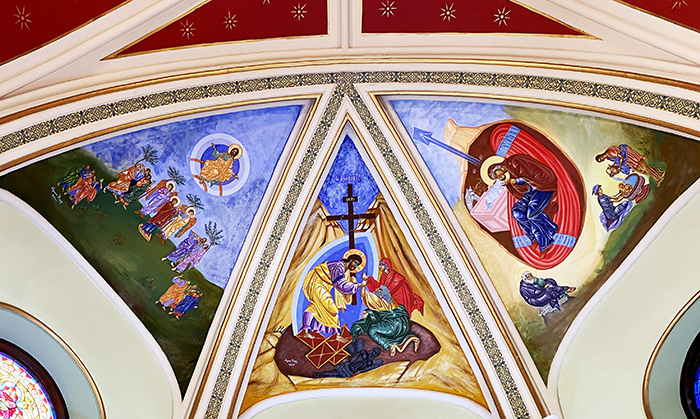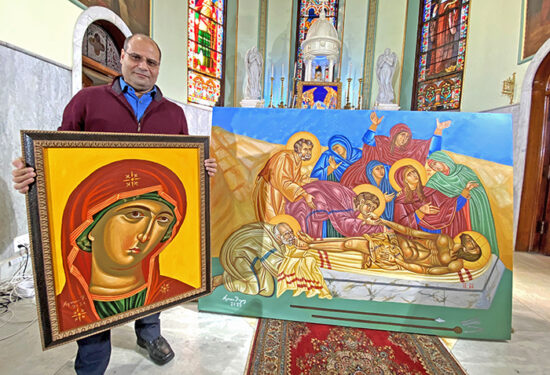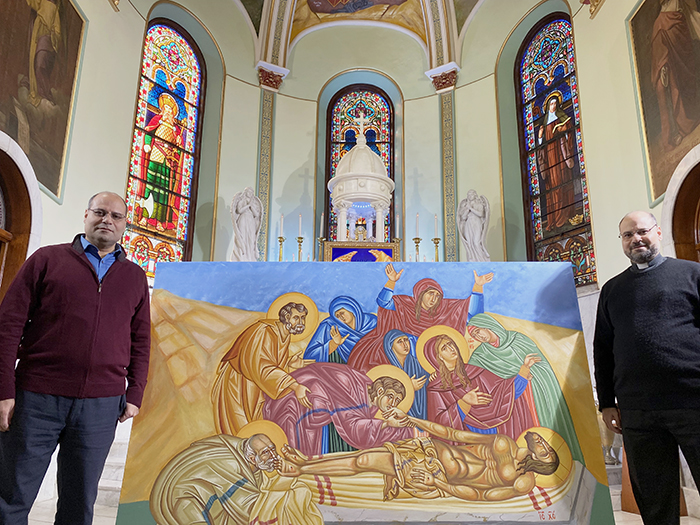
PARK SLOPE — In the 6th Century, Holy Scripture was widely available — that is, if one could afford to buy a Bible, and could actually read it.
Those who could do neither relied on icons depicting the ministry of Jesus Christ — the Gospel — so that all might learn of God’s plan for their salvation. But someone had to draw or paint these scenes, which became the mission of “iconographers.”
But an icon is not simply a picture. It is a physical representation of the Gospel itself, so iconographers don’t paint — they “write” images that convey the Word of God.
Now, some 1,400 years later, iconographers are still busy.
Among them is Ayman Fayez, of Cairo, Egypt, who has spent the past few months creating icons for the Resurrection Coptic Catholic Church in Park Slope, Brooklyn. His twin brother, Father Francis Fayez, has been the pastor there since 2013.
“I am very proud,” Father Fayez said of his brother and his work. “In 2014 he started working for us with some articles, and every year he makes one for us.”
But during his most recent visit — he arrived last September — Fayez has completed several works which were scheduled for a special blessing on Friday, Feb. 11, by Auxiliary Bishop James Massa.
The works include a large depiction of the burial of Jesus, which will be displayed at the church on Good Friday.
Fayez also recently completed the dome above the tabernacle, which now has three triangular panels depicting three Gospel passages.

Moving right to left, the first panel shows the Nativity (Matthew 1:18-25), the middle represents the triumph of Jesus’s crucifixion, as he descended into hell to rescue lost souls (I Peter 4:6, Ephesians 4:9) — in this depiction, Adam and Eve; and, finally images of Jesus ascending into heaven, leaving his disciples on earth to begin the early Church (Acts 1: 6-11).
Perfecting the Technique
Fayez makes his living as a film director and producer in Egypt. He painted as a boy, but began “writing” icons in 1987. Iconography that emerged during the Byzantine Empire is his preferred style.
Next, he continued perfecting the technique under the teachings of an Italian nun, a French priest and the Greek artist, Theodoros Papadopoulos.
Fayez, speaking through an interpreter, explained that he prefers working in the Byzantine style because to him, it is more realistic, more spiritual, and thus, more sacred — a fitting way to write the Gospel.
He works only with paints from the earth — finely-ground pigments from rocks, and whenever possible, egg yolks and water, which are created by God. Oils or acrylics aren’t used because they’re manmade.
“Any scripture in the Bible can be written as an icon,” Fayez said. “And it’s the words in the Bible that guide what (I do) in the icon, from the colors to the way (I) draw, it is all gotten from the Bible. Every color has a meaning. The way in which the hand gestures are drawn has a meaning, and it all stems from the Bible.”
Divine Inspiration
Since scripture is divinely inspired, so are the artistic efforts of an iconographer. He begins each project with deep prayer, and opens himself to guidance by the Holy Spirit. He also relies on his brother, Father Fayez, to keep him on track if he ever veers off the path of theological accuracy.
For example, Fayez said there are numerous works of art that show Jesus emerging from the tomb during the Resurrection.
Fayez noted this particular scene was not described in the Bible. Therefore, he works with what is in scripture, like the mentions of Jesus descending into hell between his burial and the resurrection.
Thus, the iconographer is not an artist, but an actual vessel used by God, Fayez said.
“The icon, in general, is a human interpretation of the signs that are in the Bible,” Fayez said. “Because the iconographer doesn’t draw from his imagination. He gets his facts, his images, his pictures, all from the Bible. So it’s basically the Bible talking through the iconographer, and then it turns up in an icon.”


So proud of you Dad 💜😍😍